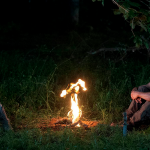Carissa Smith read Rachel Held Evans’s new book, and found it heavy on the stunts and light on thoughtful wrestling with Scripture.
As part of her exploration of “biblical” standards of modesty for women, blogger and writer Rachel Held Evans dons a full-length skirt, a slouchy sweater, and a knit beret for a month. This stunt, as you might expect (and as Held herself expects from the beginning) teaches her little about the Bible; she does claim, however, that it teaches her empathy with those whose garb leads to their being judged as religious fundamentalists, a judgment she confesses she has applied to others:
“When I saw women at the airport wearing the hijab, the first word that came to my mind was oppressed. When I saw families at the park boasting long denim skirts and tennis shoes, I labeled them sheltered. When I saw Amish buggies creeping down a busy street, I rendered their drivers legalistic, outdated. When I saw a perky coed donning a pro-life T-shirt and a ‘What Would Jesus Do?’ bracelet at a concert, I filed her under Bible-thumper. Now I feared that all those harsh words were being mentally lobbed at me. There’s perhaps no better way to foster empathy for those whose appearances you judge than to spend a few weeks walking in their shoes.”
Empathy, eh? That’s a whole lot of different groups to identify with all of a sudden. Moreover, who’s to say that the feelings of a Pentecostal woman at being judged on her apparel are the same as those of an Amish woman? Is it really possible to say you’ve walked simultaneously in the shoes of women from all these groups, based on a month-long experiment in which you wore frumpy clothing and chatted with a few Amish women?
The American obsession with claiming grand life lessons drawn from hands-on experiments is nothing new. Rachel Held Evans’s A Year of Biblical Womanhood: How a Liberated Woman Found Herself Sitting on Her Roof, Covering Her Head, and Calling Her Husband “Master” could trace its ancestry back to Henry David Thoreau’s year (two years, actually, but he pretended it was only one) living the simple life at Walden Pond. In recent years the book market has been flooded with accounts of year-long projects that began as blogs, including Julie Powell’s Julie & Julia: My Year of Cooking Dangerously and A. J. Jacobs’s The Year of Living Biblically: One Man’s Humble Quest to Follow the Bible as Literally as Possible. Evans’s book reads something like a combination of these two (in fact, in a particularly meta angle, A Year of Biblical Womanhood includes a comment from a blog reader reminding Evans that “A. J. Jacobs already did this, you know”–sadly, Evans never tells us her response to this point). Like Powell, Evans devotes a good deal of time to laying bare her own neuroses and her kitchen disasters; like Jacobs, she seeks to highlight the arbitrary nature of biblical literalism. Unlike either of these two, Evans is also genuinely seeking to know and love God better and to conform her life to the pattern of Christ: unfortunately, the description of her stunts often gets in the way of her description of her actual quest.
On the deconstructing biblical literalism front, Evans seeks to call attention to the ways in which various cultural biases have shaped Christians’ ideas of “biblical” gender roles–a fair point, in my opinion. In Evans’s discussion of some Christians’ belief that a woman’s place is exclusively in the home, she points out that “this position is based primarily on an idealized elevation of the post–industrial revolution nuclear family rather than biblical culture.” Okay, I’m with her so far. Then why spend most of the chapter discussing her attempts to transform herself into Martha Stewart?
The structure of most chapters begins with a description of Evans’s specific plans for practicing a tenet of “biblical womanhood”–gentleness, domesticity, obedience, valor, beauty, modesty, purity, fertility, submission, justice, silence, and grace–in a particular month. Many of these plans are as random as deciding that you’re going to cook your way through Martha Stewart’s Cooking School in order to practice biblical domesticity. For example, to emulate the Proverbs 31 woman, whose “husband is respected at the city gate,” Evans stands outside the entrance to her town with a sign proclaiming, “Dan is awesome!” I get the point that many Christians’ gender role prescriptions are equally arbitrary and culturally determined, but how useful is belaboring that idea with multiple examples?
On her blog, Evans has recently said that “the playful, humorous experiments” in her book “are clearly meant to be hyperbolic and provocative . . . My goal is to make readers first laugh, and then think, about the ways in which we invoke the phrase ‘biblical womanhood,’ because I believe both the Bible and womanhood are more complex than a list of rules and acceptable roles.” The main problem is that these experiments aren’t really all that funny, in part because we can so easily see through them and in part because Evans’s persona (note: her persona, not Evans herself) seems to be a distillation of all the charmingly messy, neurotic, self-deprecating women pop culture has given us in the past decade. For me, this persona is wearing thin, even in its “smart” Liz Lemon variety. I’ve begun to wonder if the type isn’t ultimately just another way for women to apologize to men for being competent: “Look, you don’t have to feel threatened, we’re just a cute little bundle of raw nerves and hormones” is the message it sends. In Evans’s case, this persona, who seems to prone to constant crying jags, undercuts her emphasis on celebrating “women of valor,” both in the Bible and throughout history. Sure, even women of valor have their weaknesses, but they don’t have to manufacture them to fit the current popular version of womanhood.
In most chapters, Evans adopts a preferable persona–the curious scholar–when she proceeds to explore various interpretations of relevant Bible passages, usually including a look at genre, context, or both. Proverbs 31 is meant to be poetry, she discovers, not a recipe for behavior. In the best chapter of the book–the “Beauty” chapter–Evans, after examining what the Bible has to say about beauty, opts to completely skip the stunts she had planned, determining that they’re unnecessary. If only she had decided the same for the whole book. What we get in the “Beauty” chapter, unhampered by the facade, is an indictment of evangelical subculture’s double standards for female appearance and sexuality and a celebration of the Bible’s better priorities–mutuality and mystery–in these matters.
Evans can also be insightful in the area of cultural analysis. For example, once we get beyond the seemingly endless narrative of apple-pie-baking, the “Domesticity” chapter suggests that maybe one reason conservative Christians rally round the flag of domesticity is that the art of homemaking, for both men and women, is genuinely in danger of being lost in our society, and that this is something to be mourned–but, Evans argues, the solution doesn’t lie in telling women that homemaking is the only vocation in which God can be found.
In her frequently reposted review of the book, Kathy Keller criticizes Evans for trying to cherry-pick her own set of culturally derived principles from scripture and for failing to distinguish between narrative and prescriptive portions of scripture. As regards the latter charge, from reading A Year of Biblical Womanhood, it’s clear to me that Evans many times makes the very genre distinctions that Keller accuses her of ignoring. Evans’s point is that others are inclined to do equally silly things when they read poetry as a list of rules. Evans also admits her cherry-picking, claiming that it’s what we all do: but, she says (possibly in desperation), we can choose good prejudices, reading with “the prejudices of love.” Yet how hard it is to achieve even a culturally trendy virtue like empathy in meaningful practice. Throughout the book, Evans makes comments like, “be careful of challenging another woman’s choices, for you never know when she may be sitting at the feet of God”–statements that seem genuine in the portions of the book in which she explores scripture but which are undermined by her various “experiments,” many of which seem aimed at not only challenging but mocking other women’s choices.
While I agree with Evans that it’s impossible to completely shed our cultural biases when approaching the Bible, I’m not confident that we can consistently apply the “prejudices of love,” either, especially not when the individual is the sole arbiter of what “love” means. Too often “love” ends up being some superficial claim to identify with another, because we want to feel better about ourselves, rather than the true death to self that the Bible enjoins for men and women, married and single. There may be no surefire way to rid ourselves of our cultural lenses, but at least we’re more aware of when we have them on if we take the time to truly listen to the voices of Christians across the centuries and from different areas of the globe–while wearing our normal apparel.
Illustration courtesy of Seth T. Hahne. Check out his graphic novel and comic review site, Good Ok Bad.











